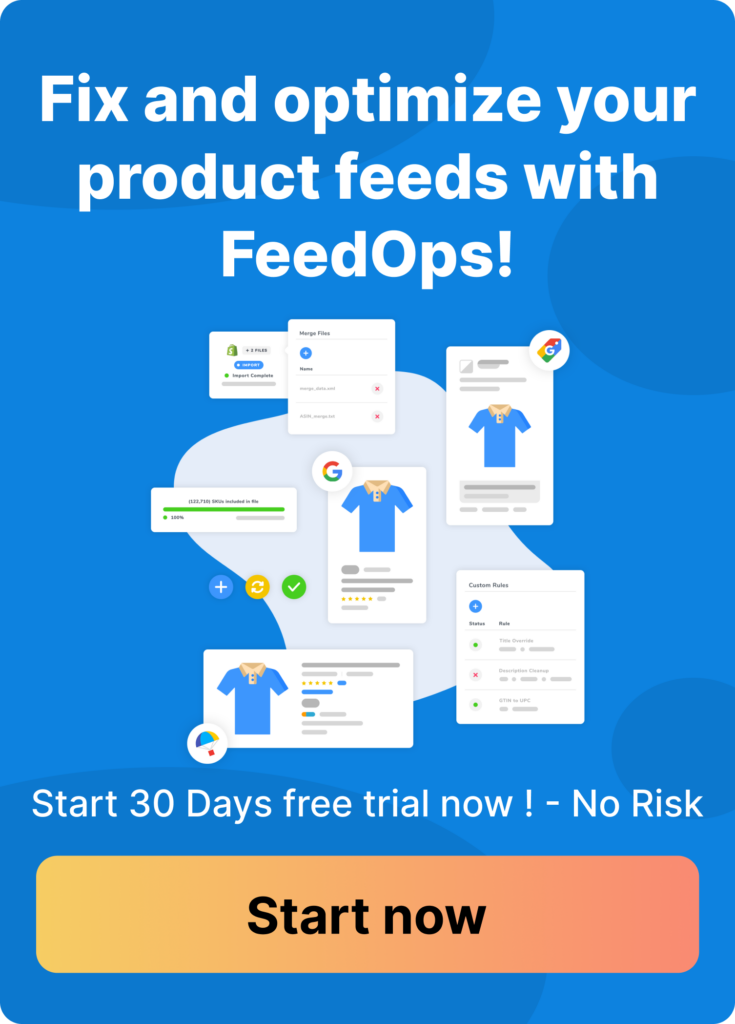You might question why there is a need to optimize a product feed at all. It’s a common misconception that simply using product data as it exists on a website is sufficient. However, when this data is sent to channels like Google Shopping or Bing Shopping, it can often lose context or become incomplete, due to the absence of web design elements and other influential factors that are present on the website.
Understanding Product Feed Optimisation
Product feeds form the backbone of any ecommerce business. They are the conduit through which your products are presented to search engines, social media platforms, and other online marketing channels. The accuracy, completeness, and presentation of your product feed directly influence how and where your products appear online, thereby affecting the visibility of your products to potential customers.
Optimizing these product feeds is not merely a suggested strategy, it’s an absolute necessity. It goes beyond just having accurate and complete information. It involves meticulously structuring this data and enhancing it in a way that makes your products stand out online, ultimately driving more traffic and increasing conversions.
The Role of AI in Advertising
Artificial Intelligence (AI) holds tremendous promise in transforming the advertising sector. Beyond automating tedious tasks and aiding with comprehensive analytics, AI has begun to show its true potential in redefining aspects of advertising that were previously heavily reliant on human input and intuition.
For instance, AI can now create and optimize advertising headlines, adapt messaging to specific audiences, and even predict optimal ad placement and timing. But these are just the tip of the iceberg when it comes to the capabilities of AI in advertising.
Perhaps most significantly, tech giants like Microsoft, Google, and Meta (formerly Facebook) are leveraging AI to predict customer behavior and purchase intent. They use AI to analyze vast amounts of data – including browsing patterns, past purchases, and even social media interactions – to identify when a shopper is most likely ready to buy a particular product.
This prediction capability is revolutionary for advertisers. It allows them to target their ads more accurately, reaching potential customers precisely when they’re most likely to make a purchase. This not only enhances the effectiveness of advertising campaigns but also significantly improves return on investment by reducing wasted ad spend on less-likely prospects.
In the context of product feed optimization, AI’s predictive abilities offer a unique opportunity. A well-optimized and complete product feed is a goldmine of data that AI can leverage to better position your products in front of potential buyers at the most opportune times.
It’s essential to ensure that your product data is thorough and the attributes align with shopper browsing and search behavior. AI can utilize this enriched data to anticipate the needs of shoppers, allowing for more accurate and efficient product matches in search results. In other words, aligning your product feed with AI-driven advertising strategies doesn’t just enhance your product visibility—it creates a tailored shopping experience that can significantly improve conversion rates.
FeedOps: The AI-Powered Optimisation Tool
FeedOps stands at the intersection of product feed optimization and AI. Our tool synergizes these complex and innovative aspects to deliver a comprehensive solution for your ecommerce needs.
FeedOps utilizes AI not just for identifying errors and suggesting enhancements, but also to enrich your product feeds. This means adding valuable information to your feeds that make your products more appealing and discoverable to potential customers. It’s like having a dedicated specialist continuously working to boost the effectiveness of your feeds.
Moreover, our AI-driven playbook provides actionable insights, allowing you to continuously improve your feeds and boost your product visibility.
Getting Started with FeedOps
Navigating through the world of product feed optimization can be a technical and complex journey, but FeedOps is here to guide you every step of the way. If at any point you feel overwhelmed or have questions, remember that you can always send us a message or book a meeting with our team. We’re eager to assist you in any way we can.
Here are some key steps to get you started on this path:
1. Connect Your Store: Begin by adding your website and connecting your store to FeedOps. This integration allows FeedOps to access your product data and begin the optimization process.
2. Audit Your Product Data: Review your first product data audit provided by our AI system. This audit will highlight areas of improvement in your product feed and guide you on the next steps to take.
3. Follow the AI-Driven Playbook: Work through the items suggested in the AI-driven playbook. The playbook offers tailored advice to optimize your product feed based on the audit’s findings.
4. Fix Missing Attributes: Ensure that all required product attributes are present in your feed. Missing or incomplete attributes can negatively impact the visibility of your product listings on advertising platforms.
5. Expand Product Type Depth: Expand your product type depth to increase the reach of your product listings and reach a broader customer base.
6. Incorporate Popular Search Terms: Make sure to include popular search terms in your product attributes, particularly in product titles and descriptions. This will make your products more discoverable in search results, increasing the chances of driving traffic and conversions.
Before you start advertising,
book a meeting or
contact us and we’ll make sure that you are correctly set up to leverage the power of your optimized product feed. We’re excited to guide you on this journey as you make the most of FeedOps in the AI-driven advertising era.



